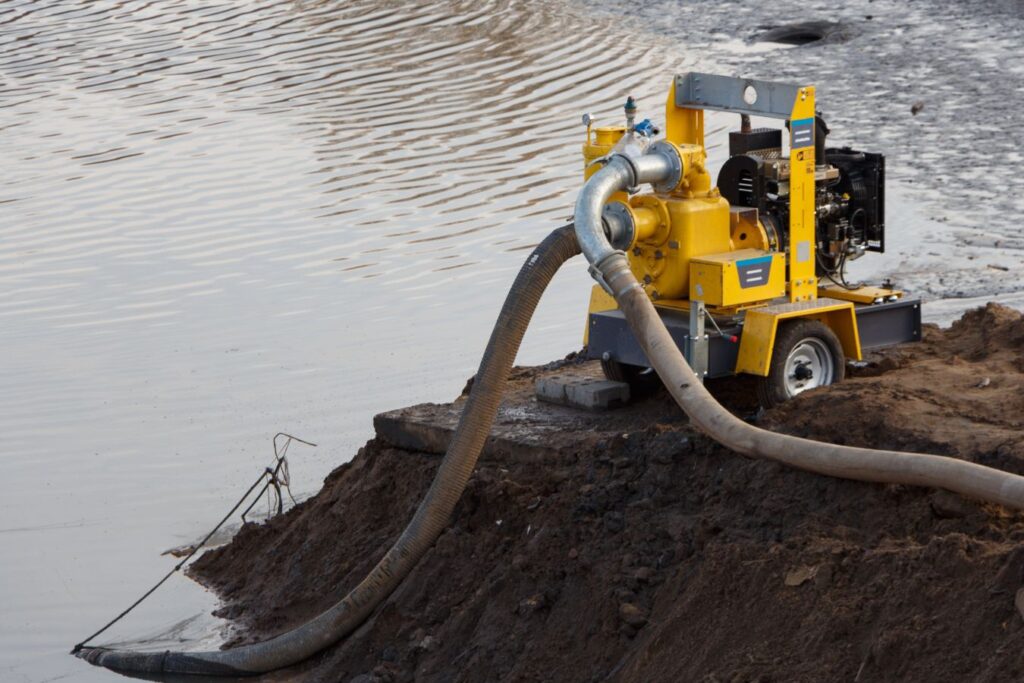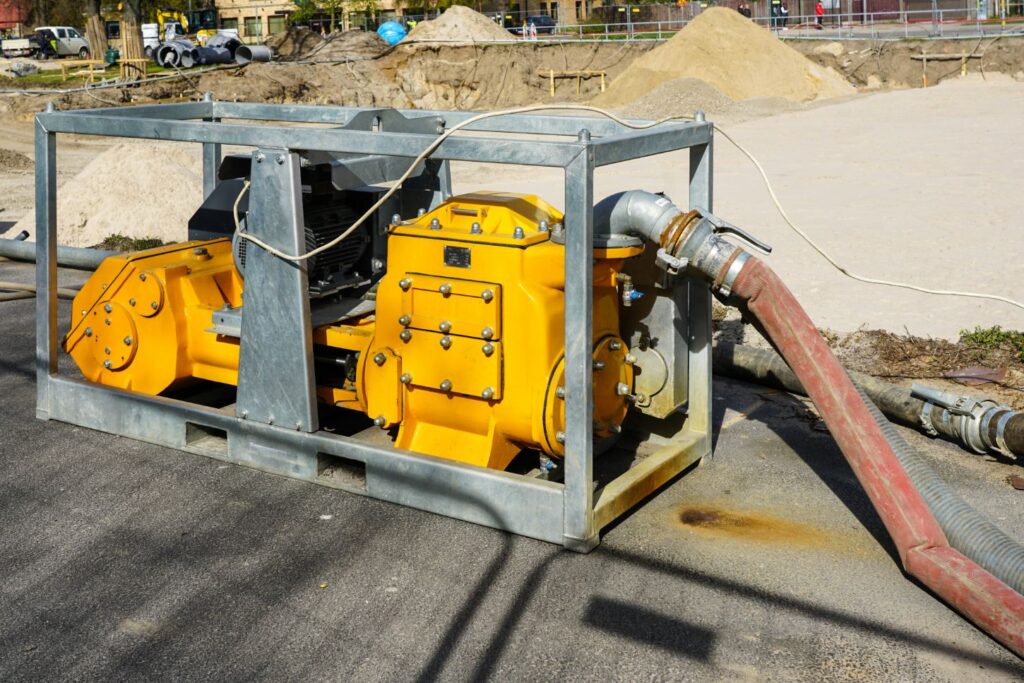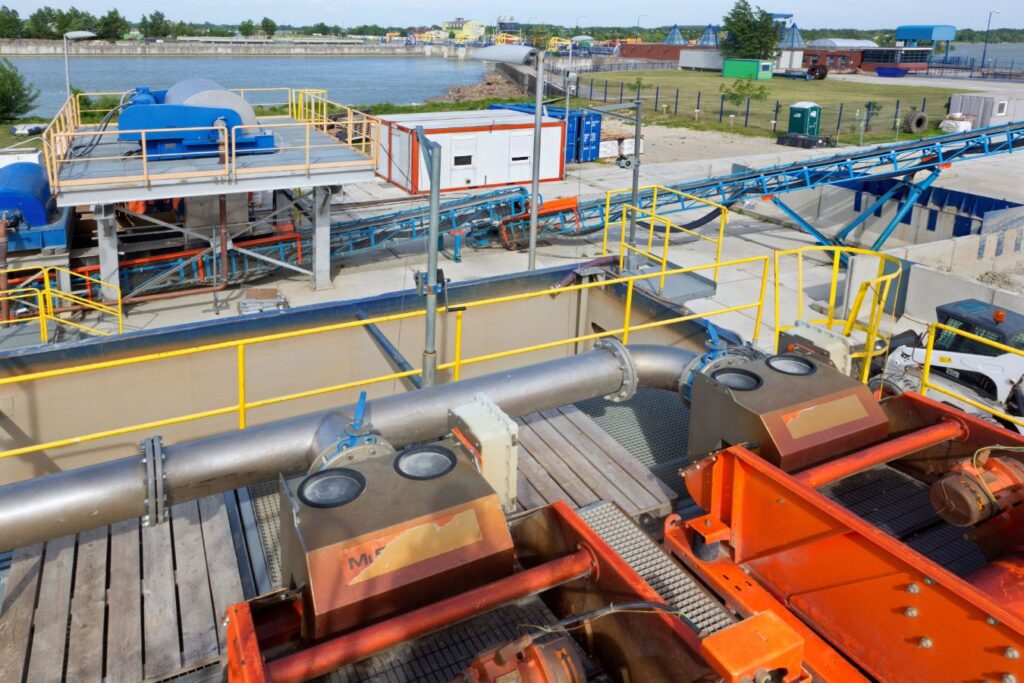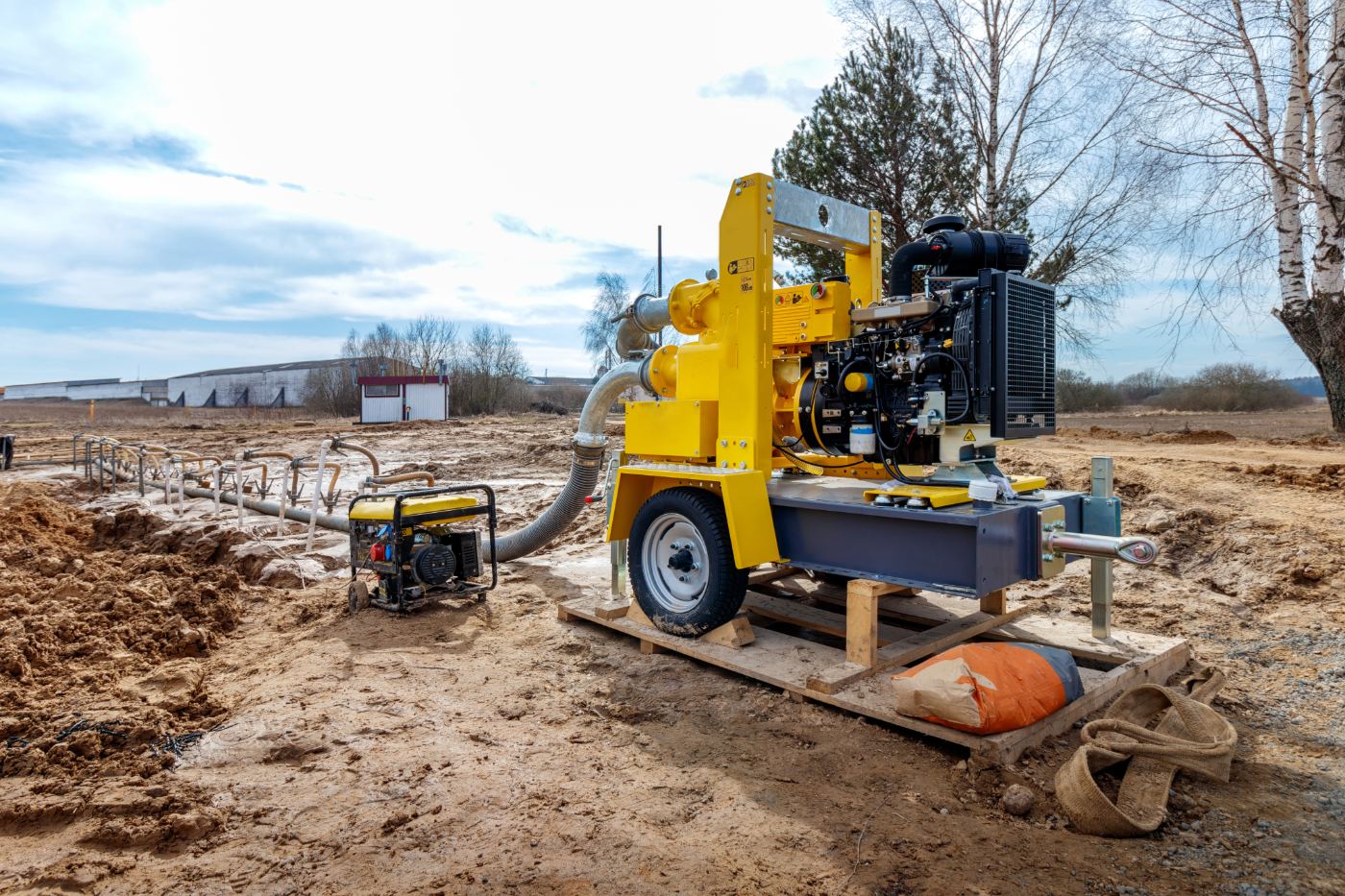Efficient sludge management is a crucial component of modern wastewater treatment systems, and sludge dewatering equipment plays a pivotal role in this process. By removing excess water from sludge, this equipment reduces volume, lowers disposal costs, and streamlines handling across a wide range of industries whether you’re operating a large municipal plant, managing an industrial facility, or working in a remote field location, selecting the right dewatering equipment, including mobile dewatering equipment for flexible operations, can dramatically improve system efficiency and environmental compliance.
What is Sludge Dewatering Equipment?
Sludge dewatering equipment is designed to separate water from sludge, reducing its volume and weight for easier handling, transportation, and disposal. This process is a critical component of wastewater treatment systems, where managing sludge efficiently can significantly reduce operational costs and enhance overall plant performance.
The working principle of sludge dewatering equipment involves applying mechanical force—via pressure, centrifugal action, or gravity—to extract water from the solids. Depending on the type of system, the sludge may pass through belts, filters, screws, or centrifuges that squeeze, spin, or compress the material. The result is a drier, more manageable cake and reduced water content in the waste stream.
Dewatering vs. Sludge Thickening
While often used interchangeably, dewatering and sludge thickening are distinct processes. Sludge thickening concentrates the solids by removing a portion of the free water, increasing the sludge’s solids content from around 1% to 5%. In contrast, dewatering equipment takes it a step further, reducing the moisture content to 10–30%, depending on the system, making the sludge easier to transport or dispose of.
Thickening is typically a pre-treatment step, while dewatering is a final stage before landfilling, incineration, or reuse.
Common Materials Handled
Modern sludge dewatering equipment is engineered to handle a wide range of sludge types generated across various sectors. Common materials include:
- Municipal sludge from wastewater treatment plants may contain organic solids, grit, and biological waste.
- Industrial sludge from food processing, chemical manufacturing, pulp and paper, textiles, and other sectors where water is heavily used in production.
- Drilling muds and construction slurry are commonly used in infrastructure and tunneling projects.
- Sludge from remote sites, best managed using mobile dewatering equipment for on-site processing without permanent infrastructure.
These machines play a vital role in minimizing the environmental footprint and ensuring compliance with disposal regulations, making them indispensable in both centralized and decentralized treatment setups.
Why Sludge Dewatering is Critical in Wastewater Treatment

Implementing sludge dewatering equipment is a crucial step in modern wastewater treatment, providing both operational and environmental benefits. From reducing volume to enhancing system efficiency, the benefits of using advanced dewatering equipment are far-reaching.
Reduction of Sludge Volume for Easier Disposal
One of the most immediate benefits of sludge dewatering equipment is the significant reduction in sludge volume. By removing excess water, the equipment produces a compact, semi-solid material that’s easier and more cost-effective to handle. Whether for land application, incineration, or landfill disposal, reduced volume translates to fewer hauls, simplified logistics, and less storage space required.
Cost Savings on Transportation and Landfill
Because water is heavy and expensive to transport, eliminating moisture from sludge results in significant cost reductions. Facilities that invest in efficient dewatering equipment often experience significant savings in transportation expenses and landfill tipping fees. Additionally, operations that require mobile or decentralized processing benefit from mobile dewatering equipment, which enables on-site treatment and immediate volume reduction, thereby eliminating the need to haul liquid sludge to remote treatment centers.
Improved Efficiency of Downstream Processes
Sludge with a high water content can hinder the performance of downstream systems, ranging from incinerators to composting facilities. Using sludge dewatering equipment ensures a more stable and consistent feedstock for these processes, boosting overall efficiency and reliability. Moreover, with less moisture to manage, odor control becomes easier, and microbial stability is better maintained.
Environmental Compliance and Sustainability Benefits
Discharging untreated or poorly managed sludge can lead to environmental violations and regulatory fines. Dewatering not only helps facilities meet stringent compliance requirements but also supports sustainability goals. By reducing the mass and moisture of sludge, dewatering equipment minimizes the environmental impact of waste disposal and facilitates the recovery or reuse of biosolids in agricultural or industrial applications. For temporary or off-grid applications, mobile dewatering equipment offers an eco-conscious solution for managing sludge without requiring permanent infrastructure.
Types of Sludge Dewatering Equipment

Choosing the right sludge dewatering equipment depends on your specific sludge characteristics, available space, energy requirements, and operational objectives. Below are the most widely used types of dewatering equipment in wastewater treatment systems, each offering distinct performance advantages.
Centrifuges
How They Work
Centrifuges use high-speed rotational force to separate solids from liquids. Sludge is introduced into a rotating drum where centrifugal acceleration pushes denser solids outward and lighter liquids inward, allowing for efficient separation.
Pros and Cons
Centrifuges are compact and offer high throughput, making them ideal for facilities with space constraints and large volumes of sludge. They are fully enclosed, reducing odor and spillage. However, they consume more energy than other types of sludge dewatering equipment and require skilled operation and maintenance.
Belt Filter Presses
Mechanism of Operation
Belt filter presses utilize a series of porous belts and rollers to squeeze water from the sludge mechanically. Sludge is conditioned with polymers, spread onto a moving belt, and passed through rollers that apply increasing pressure.
Key Applications
Common in municipal plants and industrial sites, belt filter presses are ideal for continuous operations with moderate sludge volumes. They offer a balance between performance and operating cost, though they do require regular maintenance and monitoring.
Screw Presses
Energy-Efficient and Low-Maintenance Design
Screw presses operate using a slow-moving auger within a cylindrical screen. As sludge moves forward, the pressure gradually increases, forcing water out through the screen while transporting dewatered solids to the discharge end. These units are renowned for their quiet operation, low energy consumption, and minimal wear components, making them ideal for plants seeking a low-maintenance solution for sludge dewatering equipment.
Plate and Frame Filter Press
High Solids Capture Rate
This type of dewatering equipment uses a series of plates covered with filter cloths. Sludge is pumped into the press, and pressure is applied to separate the solids from the liquids. The design enables excellent solids capture and achieves very dry sludge cakes.
Ideal Use Cases
Best suited for applications where maximum dryness is required, such as hazardous waste or high-cost disposal scenarios. While effective, these systems are typically batch-operated and require manual cleaning and setup.
Mobile Dewatering Equipment
Portability and On-Site Treatment Advantages
Mobile dewatering equipment packages the core functionality of stationary systems into trailer- or skid-mounted units. These units can be rapidly deployed to various locations, offering flexible, short-term sludge management for remote sites, emergency responses, or seasonal operations.
When to Choose Mobile Over Fixed Systems
Mobile systems are ideal when permanent infrastructure is unavailable or impractical, such as in small municipalities, industrial construction projects, or disaster recovery zones. They offer a cost-effective and scalable solution for implementing sludge dewatering equipment without requiring long-term capital investment.
Key Features to Look for in Dewatering Equipment
Selecting the right sludge dewatering equipment requires a careful evaluation of several performance metrics. Whether outfitting a permanent treatment facility or investing in mobile dewatering equipment for field operations, understanding these key features will help ensure effective, cost-efficient sludge handling.
Solids Capture Rate
One of the most critical indicators of dewatering performance is the solids capture rate—the percentage of solids retained in the sludge cake versus lost in the filtrate. High capture rates reduce the environmental burden of liquid discharge and improve overall process efficiency. Top-tier dewatering equipment should consistently achieve high capture rates across a range of varying sludge types and concentrations.
Throughput Capacity
Throughput capacity refers to the amount of sludge a unit can process per hour. This directly impacts the size and number of units needed for a given operation. Facilities with high sludge output require sludge dewatering equipment designed for continuous, high-volume processing. In contrast, smaller or decentralized operations may benefit more from flexible, lower-capacity systems, particularly in mobile dewatering equipment setups.
Energy Consumption
Energy efficiency is a growing concern in the wastewater treatment industry. Some systems, such as screw presses, offer low power consumption, while centrifuges typically consume more energy. Choosing dewatering equipment with optimized power-to-performance ratios not only reduces operational costs but also supports sustainability goals. This is especially important when using mobile systems in off-grid or fuel-sensitive environments.
Footprint and Mobility
The physical footprint of sludge handling systems matters in both permanent installations and temporary setups. Compact designs are ideal for urban facilities or retrofits with limited space. Mobile dewatering equipment, in particular, should offer easy transportability, rapid setup, and compatibility with trailers or skids, making it ideal for remote, seasonal, or emergency operations.
Automation and Control Features
Modern sludge dewatering equipment often comes equipped with programmable logic controllers (PLCs), touch-screen interfaces, and remote monitoring capabilities. These features enhance operational reliability, reduce labor demands, and allow for real-time performance adjustments. Automation is particularly valuable in uncrewed or temporary operations using mobile dewatering equipment, where on-site expertise may be limited.
Applications Across Industries

Sludge dewatering equipment is a cornerstone of effective solids management across various sectors. From municipal systems to remote industrial projects, dewatering equipment improves efficiency, reduces waste volume, and lowers disposal costs. Below are some of the most common industry applications where these systems deliver critical performance benefits.
Municipal Wastewater Treatment Plants
Municipalities generate large volumes of sludge as a byproduct of wastewater treatment. Sludge dewatering equipment plays a central role in reducing this sludge to a manageable, transportable form. By minimizing moisture content, cities can reduce hauling frequency, lower landfill fees, and comply with strict environmental regulations. In many facilities, integrating automated dewatering equipment also helps reduce labor costs and improves consistency in daily operations.
Industrial Processing Facilities
Industries such as food and beverage, chemical manufacturing, and textiles produce waste streams with high solids content. Sludge dewatering equipment is essential for managing these byproducts safely and efficiently. Depending on the material, facilities may use filter presses, screw presses, or centrifuges to optimize dryness and throughput. Tailored dewatering equipment helps prevent production downtime, ensures regulatory compliance, and supports in-plant recycling and waste reduction initiatives.
Construction and Tunneling Operations
Large-scale infrastructure projects often involve the removal of slurry and sediment from excavation and drilling activities. On these job sites, compact and rugged sludge dewatering equipment helps treat bentonite slurry, tunnel muck, and stormwater runoff. The ability to quickly reduce sludge volume supports cleaner worksites, easier handling, and regulatory adherence, especially in urban areas where water discharge is closely monitored.
Remote or Temporary Dewatering Jobs Using Mobile Dewatering Equipment
For operations in remote locations, disaster zones, or seasonal projects, mobile dewatering equipment offers unmatched flexibility. These trailer- or skid-mounted systems allow for fast deployment without the need for permanent infrastructure. Industries such as mining, oil and gas, and emergency response teams rely on mobile dewatering equipment to perform on-site sludge management, avoiding the logistical challenges and costs of transporting liquid waste to centralized facilities.
Advantages of Mobile Dewatering Equipment
While fixed systems are common in permanent treatment plants, mobile dewatering equipment offers unique advantages for projects that demand versatility, speed, and cost efficiency. These mobile units are a specialized form of sludge dewatering equipment, designed for on-site use across multiple industries and locations.
Flexibility for Multi-Site Operations
Mobile dewatering equipment is ideal for contractors, industrial operators, and service providers who manage sludge across multiple job sites. Whether it’s municipal sludge one week and industrial slurry the next, mobile units provide the flexibility to quickly shift operations without investing in multiple stationary systems. This flexibility reduces downtime and improves overall project scheduling.
Reduced Capital Costs for Smaller Municipalities or Contractors
For smaller towns, regional utilities, or independent contractors, investing in large-scale sludge dewatering equipment can be financially restrictive. Mobile systems offer a cost-effective alternative. These units require a lower upfront investment and can be shared across departments or leased when needed, making them accessible to operations with limited capital.
Fast Deployment and Setup
One of the greatest strengths of mobile dewatering equipment is its ability to be deployed quickly. These plug-and-play systems are rapidly mounted on trailers or skids and can be operational within hours of arrival on site. This is especially valuable for temporary installations or jobs with tight deadlines, such as pipeline maintenance, dredging operations, or emergency bypass pumping.
Ideal for Emergency or Seasonal Needs
When unexpected events like floods, plant breakdowns, or seasonal sludge surges occur, mobile dewatering equipment serves as a reliable backup solution. Utilities and industrial plants can quickly mobilize these systems to manage temporary sludge overloads, maintain compliance, and avoid environmental penalties. Their mobility makes them indispensable during peak operational periods when fixed dewatering equipment may already be running at full capacity.
Tips for Selecting the Right Sludge Dewatering Equipment
Choosing the right sludge dewatering equipment involves more than just comparing specs. To ensure reliable performance, low operating costs, and long-term value, it’s essential to align equipment capabilities with the specific needs of your operation. The following considerations can help you make an informed decision when evaluating both fixed and mobile dewatering equipment options.
Assessing Sludge Characteristics (Volume, Composition, Moisture Content)
Before selecting any dewatering equipment, it is essential to understand the properties of the sludge being processed. High-organic-content sludge behaves differently from grit-heavy industrial waste. Key parameters to evaluate include total solids concentration, particle size distribution, and water content. Matching these variables with the appropriate technology—whether a screw press, centrifuge, or belt press—will significantly improve performance and efficiency.
Operational Goals: Throughput vs. Dryness vs. Cost
Every operation has different priorities. Some facilities need high throughput to keep pace with production demands, while others focus on achieving the driest possible cake to reduce disposal volume. Budget constraints also play a role. Understanding whether your primary goal is speed, dryness, or cost control will help narrow down the type of sludge dewatering equipment that best suits your needs.
Footprint and Infrastructure Limitations
Space constraints can heavily influence equipment selection. Large filter presses may be impractical in urban or indoor settings, where compact units or modular, mobile dewatering equipment offer more suitable solutions. Consider the available footprint, electrical connections, and any existing infrastructure that might affect installation and operation.
Maintenance and Operator Skill Level
Some dewatering equipment requires continuous monitoring and advanced maintenance, while others offer low-maintenance, semi-automated operation. Facilities with limited staffing or technical expertise may benefit from simpler systems, such as screw presses or pre-packaged mobile dewatering equipment, which come ready to run with minimal oversight.
Mobile vs. Permanent System Needs
If your sludge management needs vary by season, job site, or emergency events, mobile dewatering equipment may be a better choice. These systems provide on-site treatment without requiring permanent construction. On the other hand, for consistent, year-round operations, a fixed dewatering solution integrated into plant infrastructure might offer better long-term ROI.
Maintenance and Optimization Best Practices
Maintaining peak performance from your sludge dewatering equipment requires consistent attention to operational procedures and routine upkeep. Regardless of whether you operate a fixed installation or use mobile dewatering equipment, following a structured maintenance plan helps extend equipment life, reduce downtime, and improve dewatering efficiency.
Regular Inspections and Preventive Maintenance
Routine inspections are essential for identifying wear, leaks, or blockages before they lead to costly failures. Components such as belts, screens, bearings, seals, and rotating assemblies should be checked regularly for signs of degradation. Establishing a preventive maintenance schedule for your dewatering equipment ensures optimal performance while avoiding unexpected breakdowns that disrupt operations.
Sludge Feed Conditioning and Polymer Dosing
Sludge conditioning is a critical factor in maximizing the efficiency of sludge dewatering equipment. Proper polymer selection and dosing enhance floc formation, allowing solids to separate more easily from liquids. Overdosing or underdosing polymers can reduce capture rates and increase costs. Testing different polymer types and adjusting feed rates according to sludge characteristics ensures consistent output and a reduced water content in the final cake.
Monitoring Key Performance Indicators (KPIs)
Tracking performance metrics allows you to fine-tune operations over time. Important KPIs for dewatering equipment include solids capture rate, cake dryness, polymer usage per ton of dry solids, energy consumption, and system throughput. Real-time data monitoring—especially in automated systems or remote mobile dewatering equipment—helps detect inefficiencies early and allows for proactive adjustments.
Training and Safety for Operators
Effective operation of sludge dewatering equipment depends on skilled personnel. Proper training ensures operators understand the machine’s workflow, safety features, and emergency protocols. Safety measures—such as lockout/tagout procedures, PPE usage, and confined space awareness—are especially important in mobile applications where site conditions can change frequently. Regular training updates help reduce human error and improve equipment handling across all job types.
Conclusion
Investing in the right sludge dewatering equipment is more than a technical decision—it’s a strategic move toward improved operational performance, cost control, and regulatory compliance. By understanding your sludge characteristics, defining your goals, and considering options such as mobile dewatering equipment for remote or temporary needs, you can develop a dewatering strategy that supports both immediate demands and long-term sustainability. With proper selection, maintenance, and optimization, dewatering becomes not just a process step but a performance driver for your entire treatment system.


